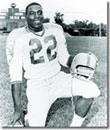
Hall of Famer Bob Hayes
(more)
Welcome to the Black College Football Museum
The mission of the Black College Football Museum is to present the untold stories and the official record of a journey traveled by generations of young black men who sought glory in a new American past time called football. The Black College Football Museum reaches as far back as the early 1890’s when the first black college football game was played in Salisbury, North Carolina. The museum will reflect the grace and dreams of young African American men who traveled from the fields of the rural south and inner cities to forge chapters in college football history that have gone untold and unacknowledged. These great athletes authored stories that weave through the fabric of three centuries of college football.
Black college football began play in 1892, so, by the turn of the 20th century, segregation was well-established and heavily managed with Jim Crow laws. Across the country, young men were learning of a new team sport called football. Universities throughout the land formed clubs and teams to allow young men an opportunity to exercise their athleticism in this new American sport. Taking root initially in the northeast corridor of the United States, football spread like wildfire. Following World War 1 the sport ignited the passions of patriotism, pride and school spirit as America had found a new past time.
Football had also found a home in the Negro colleges. From the cotton fields of the South to the slums of major cities, young black boys dreamed of glory in this newfound game with the only problem being that they couldn’t play the sport wherever they wanted. So, for more than seventy years, young black college-bound football players flocked to black institutions of higher learning. While the major state institutions allowed only a trickle of black players into their programs, the vast majority of black football players, prior to 1965, played their college careers at historically black schools, under the guidance and tutelage of astute coaches who, with little notoriety or glamour, gave of themselves for their love of the student-athletes and the game.
Born of farms, tobacco fields and city neighborhoods and with little to no formal education of this game, these teachers of men persevered with a steadfast will to educate and inspire. These coaches/educators proved themselves to be more than up to the task as they faced inferior facilities, less than stellar equipment and very few venues in which to showcase the enormous talent, thus establishing a trend that continues through today.
The history of black college football is rich with stories, statistics and proven innovative contributions to the game of football that have impacted the sport at every level, ranging from Pop Warner to the National Football League (NFL).Therefore, it is the overriding goal and intent of the BCFM to capture, record, archive and disseminate this treasured information. Please enter through these web doors to the past and join us in reliving the largely unnoticed and overlooked segment of one of the brightest periods in the birth of a new age in sports. In an unusual but thrilling addition to the gridiron lure of black college football the museum will also document the soul of the game. The soul of the game is the marching band halftime shows that black college football have perfected throughout the years. The halftime shows are as competitive as the football games. So in addition to the football programs, the museum intends to honor the commitment of the marching bands of historically black college and universities.
